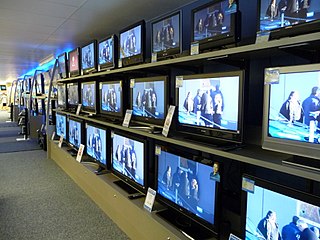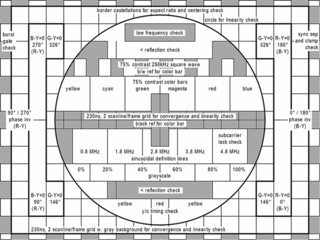
Analog television or analogue television is the original television technology that uses analog signals to transmit video and audio. In an analog television broadcast, the brightness, colors and sound are represented by rapid variations of either the amplitude, frequency or phase of the signal.
Digital television (DTV) is the transmission of television signals, including the sound channel, using digital encoding, in contrast to the earlier television technology, analog television, in which the video and audio are carried by analog signals. It is an innovative advance that represents the first significant evolution in television technology since color television in the 1950s. Digital TV transmits in a new image format called HDTV, with greater resolution than analog TV, in a wide screen aspect ratio similar to recent movies in contrast to the narrower screen of analog TV. It makes more economical use of scarce radio spectrum space; it can transmit multiple channels, up to 7, in the same bandwidth occupied by a single channel of analog television, and provides many new features that analog television cannot. A transition from analog to digital broadcasting began around 2006 in some countries, and many industrial countries have now completed the changeover, while other countries are in various stages of adaptation. Different digital television broadcasting standards have been adopted in different parts of the world; below are the more widely used standards:

An electrical telegraph is a telegraph that uses electrical signals, usually conveyed via dedicated telecommunication circuit or radio.

NTSC, named after the National Television System Committee, is the analog television color system that was used in North America from 1954 and until digital conversion, was used in most of the Americas ; Myanmar; South Korea; Taiwan; Philippines; Japan; and some Pacific island nations and territories.

Television (TV), sometimes shortened to tele or telly, is a telecommunication medium used for transmitting moving images in monochrome, or in colour, and in two or three dimensions and sound. The term can refer to a television set, a television program, or the medium of television transmission. Television is a mass medium for advertising, entertainment and news.

Telegraphy is the long-distance transmission of textual or symbolic messages without the physical exchange of an object bearing the message. Thus semaphore is a method of telegraphy, whereas pigeon post is not.

Wireless telegraphy means transmission of telegraph signals by radio waves; a more specific term for this is radiotelegraphy. Before about 1910 when radio became dominant, the term wireless telegraphy was also used for various other experimental technologies for transmitting telegraph signals without wires, such as electromagnetic induction, and ground conduction telegraph systems.

Slow Scan television (SSTV) is a picture transmission method used mainly by amateur radio operators, to transmit and receive static pictures via radio in monochrome or color.

Shortwave radio is radio transmission using shortwave radio frequencies. There is no official definition of the band, but the range always includes all of the high frequency band (HF), and generally extends from 1.7–30 MHz (176.3–10.0 m); from the high end of the medium frequency band (MF) just above the mediumwave AM broadcast band, to the end of the HF band.

Terrestrial television is a type of television broadcasting in which the television signal is transmitted by radio waves from the terrestrial (Earth-based) transmitter of a television station to a TV receiver having an antenna. The term terrestrial is more common in Europe and Latin America, while in the United States it is called broadcast or over-the-air television (OTA). The term "terrestrial" is used to distinguish this type from the newer technologies of satellite television, in which the television signal is transmitted to the receiver from an overhead satellite, and cable television, in which the signal is carried to the receiver through a cable.

Amateur television (ATV) is the transmission of broadcast quality video and audio over the wide range of frequencies of radio waves allocated for radio amateur (Ham) use. ATV is used for non-commercial experimentation, pleasure, and public service events. Ham TV stations were on the air in many cities before commercial television stations came on the air. Various transmission standards are used, these include the broadcast transmission standards of NTSC in North America and Japan, and PAL or SECAM elsewhere, utilizing the full refresh rates of those standards. ATV includes the study of building of such transmitters and receivers, and the study of radio propagation of signals travelling between transmitting and receiving stations.

Radiofax, also known as weatherfax and HF fax, is an analogue mode for transmitting monochrome images. It was the predecessor to slow-scan television (SSTV). Prior to the advent of the commercial telephone line "fax" machine, it was known, more traditionally, by the term "radiofacsimile". The cover of the regular NOAA publication on frequencies and schedules states "Worldwide Marine Radiofacsimile Broadcast Schedules".
The Automatic Picture Transmission (APT) system is an analog image transmission system developed for use on weather satellites. It was introduced in the 1960s and over four decades has provided image data to relatively low-cost user stations at locations in most countries of the world. A user station anywhere in the world can receive local data at least twice a day from each satellite as it passes nearly overhead.

Mechanical television or mechanical scan television is a television system that relies on a mechanical scanning device, such as a rotating disk with holes in it or a rotating mirror, to scan the scene and generate the video signal, and a similar mechanical device at the receiver to display the picture. This contrasts with modern television technology, which uses electronic scanning methods, for example electron beams in cathode ray tube (CRT) televisions, and liquid-crystal displays (LCD), to create and display the picture.

The history of telecommunication began with the use of smoke signals and drums in Africa, the Americas and parts of Asia. In the 1790s, the first fixed semaphore systems emerged in Europe; however it was not until the 1830s that electrical telecommunication systems started to appear. This article details the history of telecommunication and the individuals who helped make telecommunication systems what they are today. The history of telecommunication is an important part of the larger history of communication.
The invention of the television was the work of many individuals in the late 19th century and early 20th century. Individuals and corporations competed in various parts of the world to deliver a device that superseded previous technology. Many were compelled to capitalize on the invention and make profit, while some wanted to change the world through visual and audio communication technology.

An ATSCtuner, often called an ATSC receiver or HDTV tuner is a type of television tuner that allows reception of digital television (DTV) television channels transmitted by television stations in North America, parts of Central America and South Korea that use ATSC standards. Such tuners may be integrated into a television set, VCR, digital video recorder (DVR), or set-top box that provides audio/video output connectors of various types.
Satellite television is a service that delivers television programming to viewers by relaying it from a communications satellite orbiting the Earth directly to the viewer's location. The signals are received via an outdoor parabolic antenna commonly referred to as a satellite dish and a low-noise block downconverter.

Telecommunications engineering is an engineering discipline centered on electrical and computer engineering which seeks to support and enhance telecommunication systems. The work ranges from basic circuit design to strategic mass developments. A telecommunication engineer is responsible for designing and overseeing the installation of telecommunications equipment and facilities, such as complex electronic switching systems, and other plain old telephone service facilities, optical fiber cabling, IP networks, and microwave transmission systems. Telecommunication engineering also overlaps with broadcast engineering.

Telecommunication is the transmission of signs, signals, messages, words, writings, images and sounds or information of any nature by wire, radio, optical or other electromagnetic systems. Telecommunication occurs when the exchange of information between communication participants includes the use of technology. It is transmitted either electrically over physical media, such as cables, or via electromagnetic radiation. Such transmission paths are often divided into communication channels which afford the advantages of multiplexing. Since the Latin term communicatio is considered the social process of information exchange, the term telecommunications is often used in its plural form because it involves many different technologies.
















